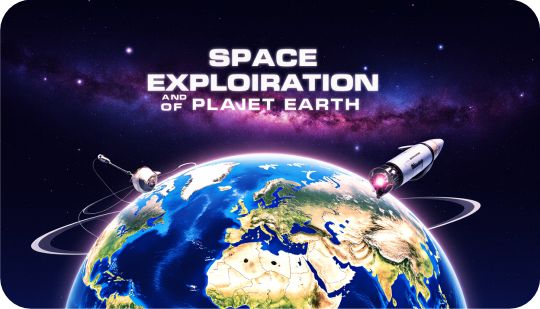Space exploration shapes Earth’s future through technology, climate insights, and global cooperation.
- Arts Design
- Engineering and Technology
- Agriculture and Natural Resources
- Arts and Humanities
- Biological Sciences
- Business, Management, and Economics
- Civil Engineering
- Earth Sciences
- Health Sciences
- Humanities and Social Sciences
- Management Sciences
- Environmental Sciences and Natural Resources
-
Medicine
- Anesthesia
- Internal Medicine
- Plastic Surgery and Otorhinolaryngology (ENT)
- Public Health
- Sports Medicine and Rehabilitation
- Basic Medical Sciences
- Behavioral Sciences and Psychology
- Blood and Cancer
- Cardiology and Cardiac Surgery
- Dentistry
- Dermatology
- Emergency
- Gynecology and Obstetrics
- Neurology
- Nursing
- Nutrition
- Ophthalmology
- Orthopedic
- Pathology and Laboratory Sciences
- Pediatrics
- Pharmacy
- Radiology
- Surgery
- Urology
- Veterinary Medicine
- Natural Sciences
- Smart Technologies
- Social Sciences
Space Exploration and the Future of Planet Earth

Before diving into particular missions or technologies, it helps to understand why space exploration matters not just for astronauts, but for everyone on Earth. Key reasons include:
- Understanding Earth systems — satellites give us precious data on climate change, environmental degradation, natural disasters, and more, enabling earlier warning, better models, and smarter policymaking.
- Technological spillovers — many tools developed for space (materials, robotics, data processing) find applications back on Earth in medicine, infrastructure, agriculture, communications, and more.
- Resource security and sustainability — as Earth’s population and demand for resources increases, space offers prospects (though challenging) for off-Earth resources, energy systems, and perhaps new habitats.
- International cooperation / geopolitics — space missions increasingly become symbols and platforms for global collaboration, addressing shared risks like asteroid impacts, climate crisis, debris management, and space weather.
Key Recent Trends & Missions Impacting Earth’s Future (2024–2025)
1. Earth Observation & Remote Sensing
New Earth Observation (EO) systems — including hyperspectral imaging and improved spatial resolution — provide richer datasets for tracking climate indicators, coastlines, biodiversity, glaciers, deforestation, and more.
These advances improve predictive climate models, help in disaster response, support precision agriculture, and guide global emissions efforts.
2. Commercialization & Private Sector Growth
The space industry is no longer dominated only by national agencies. Private companies now launch small satellites and offer services such as Earth imaging and communications.
Increased launch frequency, reduced costs, reusability, and smaller satellite designs mean more affordable, frequent data and improved service coverage (broadband, weather, disaster surveillance).
3. Lunar & Deep-Space Missions with Earth Implications
Programs like Artemis aim to create sustainable lunar activity, testing systems for harsh environments, resource extraction, and habitation technologies that have Earth-relevant lessons.
Planned missions such as Chang’e-8 target in-situ resource utilization and technology demonstration that could inform future Mars exploration and terrestrial technologies.
4. Sustainability in Space and Orbital Environment
The rapid increase in satellites and space traffic raises concerns about orbital debris, space pollution, and the long-term sustainability of Earth’s orbital commons.
Innovations like efficient propulsion, reusable rockets and less-polluting materials are emerging to reduce environmental cost and improve longevity.
5. Space Weather & Sun Activity
Stronger solar activity—flares and geomagnetic storms—can affect satellites, power grids, GPS, and communications on Earth. Monitoring and preparedness are now a core part of infrastructure planning.
6. Sample-Return Missions and Scientific Discovery
Sample-return missions (asteroids, comets, lunar samples) deepen our understanding of the solar system, origins of water and organics, and long-term planetary hazards—knowledge that informs how we protect Earth.
How These Trends Shape Earth’s Future: Opportunities and Challenges
Opportunities
- Improved Climate Resilience — better remote sensing and analytics enable earlier detection of climate risks and faster adaptation.
- Resource Management & Food Security — precision agriculture from satellite data optimizes water use and detects crop stress.
- Disaster Warning & Mitigation — satellites map floods, wildfires, volcanic activity and support coordinated emergency responses.
- Scientific Knowledge & Education — missions expand understanding of Earth and inspire STEM learning.
- New Economic Sectors — satellite services, space tourism, in-space manufacturing, and potential off-Earth resource industries create jobs and markets.
- Global Collaboration — shared missions and treaties foster cooperation across nations and institutions.
Challenges & Risks
- Orbital Debris & Space Junk — growing debris increases collision risk and threatens vital satellite services.
- Regulatory & Governance Issues — questions remain about ownership and regulation of lunar resources and commercial activities in space.
- Space Weather Vulnerabilities — severe solar storms can disrupt critical infrastructure on Earth.
- Environmental Footprint & Sustainability — launch emissions, material waste, and space-side pollution raise environmental concerns.
- Economic & Budget Constraints — high costs and shifting priorities can delay or cancel important missions.
- Technological Risks & Safety — long-distance human missions involve radiation, microgravity, and contamination risks.
What Needs to Be Done: Guidelines for a Beneficial Future
To ensure space exploration benefits Earth, several best practices are emerging:
- Develop Sustainable Space Policies — international cooperation on debris mitigation, orbital traffic management, and resource use.
- Invest in Earth Observation Infrastructure — more satellites, better sensors, and open data policies to improve resilience and decision-making.
- Increase Resilience to Space Weather — harden satellites, improve forecasts, and build redundancy for critical networks.
- Promote Dual-Use Technologies — support developments that serve both space missions and terrestrial needs (materials, robotics, AI).
- Ensure Ethical, Inclusive Collaboration — include diverse countries and communities to avoid reproducing inequalities in space.
- Support Public Engagement and Education — foster public understanding of space’s costs, benefits, and stakes; inspire future generations.
Big Missions & Projects to Watch (2025–2030+)
- Artemis Program (NASA & partners) — multiple lunar missions, Gateway infrastructure, and groundwork for Mars expeditions.
- Chang’e-8 (China) — lunar exploration focused on in-situ resource utilization and international collaboration.
- Tianwen-2 (China) — asteroid/comet sample-return missions yielding scientific insights.
- Satellite Mega-Constellations & Small Satellites — rising numbers of low-cost satellites for communications, monitoring, and IoT, with regulatory implications.
Conclusion
Exploring space is no longer just about the stars or scientific curiosity — it is deeply relevant to the future of Earth. From observing climate to strengthening infrastructure, discovering resources, and fostering cooperation, activities beyond Earth’s atmosphere feed back into life at home. If contemporary and future space exploration is pursued sustainably, ethically, and inclusively, it can help safeguard and enhance life on Earth for generations to come.
Share this post:







0 Comments